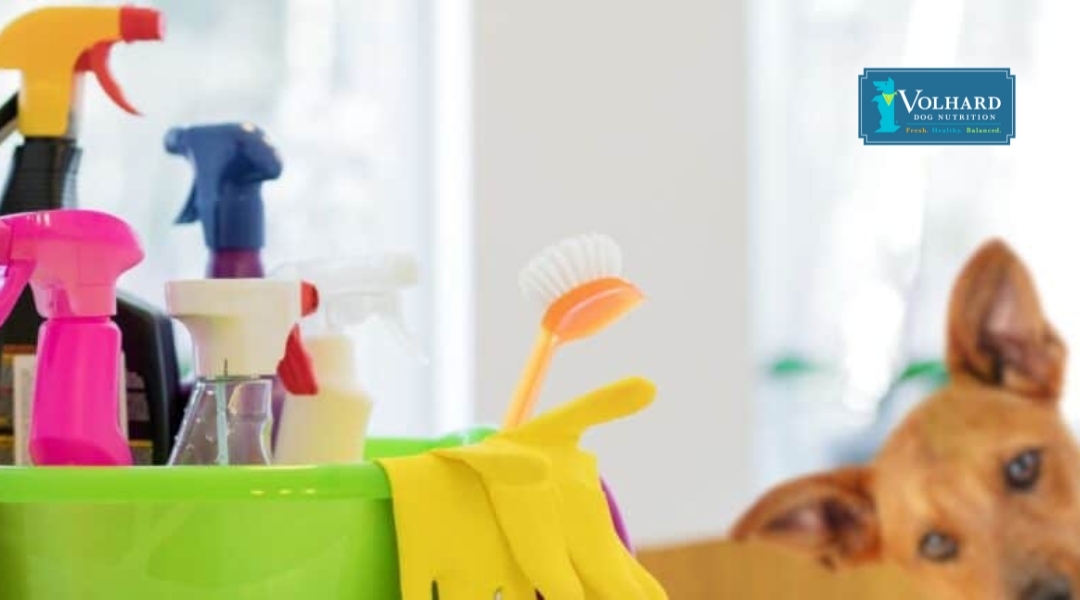Borax Poisoning in Dogs: Symptoms and Emergency Care
Posted by Volhard Dog Nutrition on May 26th 2025
It’s a scenario many dog owners never see coming: one minute your pet is exploring the house like usual, the next they’re showing signs of distress—drooling, vomiting, or struggling to stand.
The culprit is often something hiding in plain sight. Borax, a common ingredient in household cleaners and DIY solutions, is one of those sneaky hazards that can pose serious risks to dogs, even in small amounts.
Many well-meaning pet owners assume that products labeled “natural” or “non-toxic” are automatically safe for animals. Unfortunately, that’s not always true. From spotting the early signs to taking quick action and preventing future incidents, here’s what every dog owner should know about borax safety.
What is Borax, and Where Is It Found in the Home?

Borax, or sodium borate, is a naturally occurring mineral that’s commonly used in household cleaning and pest control products. While it’s often promoted as a “green” alternative to harsh chemicals, that doesn’t mean it’s safe, especially for pets.
You’ll typically find borax in:
- Laundry boosters and detergents.
- All-purpose household cleaners.
- Ant and cockroach killers.
- DIY slime recipes and craft materials.
- Carpet deodorizers.
- Toilet bowl tablets.
- Mold and mildew removers.
Why Dogs are Vulnerable to Borax Exposure
Borax becomes harmful to dogs because of how it interferes with essential biological processes. When ingested, inhaled, or absorbed through the skin, borax acts as a cellular toxin, disrupting enzyme function, damaging the gastrointestinal lining, and affecting the nervous system and kidneys.
Even relatively small amounts can overwhelm a dog’s ability to detoxify the substance, leading to a rapid onset of symptoms such as vomiting, diarrhea, tremors, or even seizures.
Dogs have a much smaller body mass than humans, meaning that even minimal exposure can deliver a relatively large dose of toxin compared to their weight. Puppies, senior dogs, and those with preexisting health conditions are especially at risk, as their systems are less capable of managing toxic substances. Compounding this is the fact that dogs often groom themselves by licking, which makes secondary ingestion likely if borax gets on their coat or paws.
Because of these combined factors—how borax affects the body, how dogs interact with their environment, and how easily accessible borax can be in the home—dogs are at a significantly higher risk of harm.

Recognizing the Signs of Borax Poisoning
Borax poisoning symptoms can show up fast, sometimes within just 30 minutes. Look for:
- Vomiting (potentially with traces of blood).
- Excessive drooling.
- Diarrhea.
- Signs of abdominal discomfort.
As toxicity increases, dogs may exhibit tremors, lethargy, weakness, or even seizures. You might also notice skin redness or irritation if borax comes into direct contact with their fur or paws.
Immediate Actions to Take at Home
Prior to an emergency, ensure your first aid kit includes activated charcoal. Use it only when instructed by a veterinarian.
If you suspect your dog has come into contact with borax:
- Remove your dog from the area and block access to it.
- If it’s on their skin or coat, rinse thoroughly with lukewarm water—no harsh soaps.
If ingested:
- Call your vet or a pet poison hotline immediately before attempting any treatment. Ask your vet how to safely administer activated charcoal if applicable.
- Bring along the product label for reference.
Once your dog is stabilized and under veterinary care, you can begin thinking about long-term support
Holistic Approaches to Recovery
Volhard Dog Nutrition’s Digestive Enzymes help repair the gut lining, often irritated by exposure to borax, and aid in nutrient absorption, which is crucial for dogs recovering from toxin-related distress.
Feeding a whole-food diet is one of the most important ways to support recovery after poisoning. Our Rescue and NDF2 diets offer balanced, nutrient-rich meals made from real, minimally processed ingredients.
Our diets promote gut health, reduce inflammation, and give the body the fuel it needs to heal. Fresh proteins and anti-inflammatory ingredients, such as leafy greens and berries, can help detoxify the liver and stabilize energy levels.

Preventing Future Incidents With Pet-Safe Alternatives
Once you’ve experienced the stress of a toxic exposure like borax poisoning, prevention becomes a top priority. The good news is that you don’t need harsh chemicals to keep your home clean and fresh-smelling.
Switching to pet-safe alternatives not only protects your dog but also contributes to better long-term health for the whole family. Look for cleaning products that are clearly labeled as pet-safe and avoid those containing borates, chlorine, ammonia, or artificial fragrances.
If you're making DIY cleaners, double-check that all ingredients are non-toxic for pets—what’s safe for humans isn’t always safe for dogs. Keeping all cleaners, even natural ones, in secure, high cabinets and cleaning up spills immediately is another essential habit to prevent accidental contact.
Dog-Safe Natural Cleaning Products
Natural cleaning doesn’t mean less effective—it just means safer ingredients. Products made with vinegar, baking soda, castile soap, and essential oils (in dog-safe concentrations) can be used to sanitize without leaving behind harmful residues.
Brands that are transparent about their ingredients and explicitly state they are pet-safe are your best bet. Always avoid essential oils like tea tree, clove, and eucalyptus in high concentrations, as these can be toxic to dogs.
Creating a Low-Toxin Home Environment
- Choose pet-safe feeding bowls over plastic. Wash your dog's bedding with fragrance-free, borax-free detergents, and ventilate your home regularly to reduce the amount of airborne toxins.
- Consider investing in an air purifier, especially if you live in an urban area or use gas appliances.
Supporting your dog’s system from the inside out reduces the risk of long-term damage and helps build resilience against future environmental exposures.

Fuel Recovery and Wellness With Volhard Dog Nutrition’s Natural Support!
From detox to daily nourishment, Volhard Dog Nutrition offers trusted, whole-food solutions to help your dog recover and thrive after exposure to borax.
For more advice on dog nutrition, health, and training, contact us and check out our other blogs!
Volhard Dog Nutrition and its expert canine nutrition coaches offer online consultations to help more dog parents discover why and how to feed their dogs the healthiest foods!
Speaking to a Volhard canine nutrition coach will help you understand the inseparable relationship between healthy food, a healthy body, and a healthy mind.
If you want to contact one of our Volhard canine nutrition coaches, don't hesitate to access our consultation page!
References:
- "Boric Acid." Boric Acid Technical Fact Sheet, www.npic.orst.edu/factsheets/archive/borictech.html. Accessed 24 Apr. 2025.
- Campbell, Alexander, and Michael Chapman. Handbook of Poisoning in Dogs and Cats. John Wiley & Sons, Ltd, 2008. Accessed 24 Apr. 2025.
- "Inorganic Herbicides and Organic Arsenicals Toxic to Animals - Toxicology." MSD Veterinary Manual, www.msdvetmanual.com/toxicology/herbicide-poisoning/inorganic-herbicides-and-organic-arsenicals-toxic-to-animals. Accessed 24 Apr. 2025.

